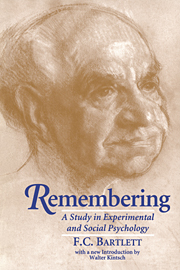Book contents
- Frontmatter
- Contents
- Biography of Sir Frederic C. Bartlett
- Introduction by Walter Kintsch
- Preface
- PART I EXPERIMENTAL STUDIES
- Chapter I Experiment in Psychology
- Chapter II Experiments on Perceiving
- Chapter III Experiments on Imaging
- Chapter IV Experiments on Remembering: (a) The Method of Description
- Chapter V Experiments on Remembering: (b) The Method of Repeated Reproduction
- Chapter VI Experiments on Remembering: (c) The Method of Picture Writing
- Chapter VII Experiments on Remembering: (d) The Method of Serial Reproduction; I
- Chapter VIII Experiments on Remembering: (e) The Method of Serial Reproduction; II. Picture Material
- Chapter IX Perceiving, Recognising, Remembering
- Chapter X A Theory of Remembering
- Chapter XI Images and their Functions
- Chapter XII Meaning
- PART II REMEMBERING AS A STUDY IN SOCIAL PSYCHOLOGY
- Index
- Plate section
Chapter V - Experiments on Remembering: (b) The Method of Repeated Reproduction
Published online by Cambridge University Press: 04 August 2010
- Frontmatter
- Contents
- Biography of Sir Frederic C. Bartlett
- Introduction by Walter Kintsch
- Preface
- PART I EXPERIMENTAL STUDIES
- Chapter I Experiment in Psychology
- Chapter II Experiments on Perceiving
- Chapter III Experiments on Imaging
- Chapter IV Experiments on Remembering: (a) The Method of Description
- Chapter V Experiments on Remembering: (b) The Method of Repeated Reproduction
- Chapter VI Experiments on Remembering: (c) The Method of Picture Writing
- Chapter VII Experiments on Remembering: (d) The Method of Serial Reproduction; I
- Chapter VIII Experiments on Remembering: (e) The Method of Serial Reproduction; II. Picture Material
- Chapter IX Perceiving, Recognising, Remembering
- Chapter X A Theory of Remembering
- Chapter XI Images and their Functions
- Chapter XII Meaning
- PART II REMEMBERING AS A STUDY IN SOCIAL PSYCHOLOGY
- Index
- Plate section
Summary
DESCRIPTION OF THE METHOD
TheMethod of Repeated Reproduction follows almost exactly the plan of investigation adopted by Philippe in his experiments Sur les transformations de nos images mentales, except that the material used was different and the experiments themselves were continued for a much longer period. A subject was given a story, or an argumentative prose passage, or a simple drawing to study under prescribed conditions. He attempted a first reproduction usually after an interval of 15 minutes, and thereafter gave further reproductions at intervals of increasing length. By using this method I hoped to find something about the common types of change introduced by normal individuals into remembered material with increasing lapse of time. Obviously the nature of the experiment renders it rather hazardous to speculate as to the exact conditions of change, but it is fairly easy to keep a check on the progressive nature of such transformations as actually occur.
There is one difficulty which is particularly acute. I hoped to continue to get reproductions until the particular material concerned had reached a stereotyped form. If reproductions are effected frequently, however, the form tends to become fixed very rapidly, while if long intervals are allowed to elapse between successive reproductions the process of gradual transformation may go on almost indefinitely. Consequently, the results of the experiment as they are here described no doubt represent a section only of an incomplete process of transformation.
Further, it is certain that in the transformations of material which, for example, produce the popular legend, or which develop current rumours, social influences play a very great part.
- Type
- Chapter
- Information
- RememberingA Study in Experimental and Social Psychology, pp. 63 - 94Publisher: Cambridge University PressPrint publication year: 1995



